Susanna White’s Nanny McPhee And The Big Bang (2010) introduces Mr Edelweiss as Nanny McPhee’s mischievous sidekick. Mr Edelweiss is a Jackdaw crow, a member of the Corvid species, who are known for their thieving habits. This scene is particularly interesting as the human-animal relationship portrayed causes a shift in the predicted stock characters of this film. Nanny McPhee, the expected protagonist, can be analysed through an antagonistic lens as it is her actions which could be the consequence of potentially traumatic experiences for the children she is trying to teach. Differentiating from this, Mr Edelweiss is the saviour of these possible events which foreshadows his heroic status at the end of the film. Despite Nanny McPhee’s hateful manner towards the crow throughout this scene, it is surprising that Mr Edelweiss still comes to the rescue, suggesting his loyalty to both the children, and his ‘superior’.
The scene consists of five children and Nanny McPhee, prior to Mr Edelweiss’s entrance the children are frozen in time (Figure 1). It is clear that Nanny McPhee is unhappy with Mr Edelweiss due to events before the film and this is beginning to project throughout this short scene. Nanny McPhee discloses that Mr Edelweiss ate all of her window putty, causing all of her window panes to fall out. He uses his playful and mischievous nature in an attempt to win over his companion by returning the almost burnt letters (Figure 2). This scene represents the conflicted and troublesome human-animal relationship between the duo through the contrasting tone of Nanny McPhee’s dialogue and the playful movements of Mr Edelweiss. Due to this film being targeted towards children, having a significant ocular contrast between the movements of Mr Edelweiss and the dialogue of Nanny McPhee creates a more accessible understanding as it aids to reveal information about both of the characters individually, human as stern and animal as playful, whilst simultaneously revealing the nature of their relationship. It is through this initial human-animal interaction that establishes the disapproving tone of Nanny McPhee towards Mr Edelweiss for the rest of the film.
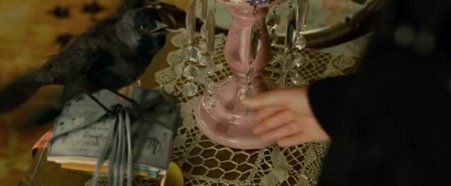
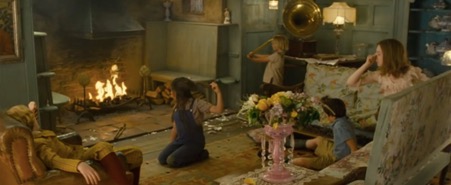
Vulnerability and empathy can be identified within this scene. The empathetic nature that Mr Edelweiss has towards the children contrasts to Nanny McPhee’s harsh teaching methods. This is significant as Mr Edelweiss is breaking his loyalty to Nanny McPhee to help retrieve the letters that are hovering above the active fireplace. As well as this, it is through Mr Edelweiss’s empathetic actions that place him in a state of vulnerability, first through breaking the wishes of Nanny McPhee, as well as flying towards the fire which could potentially harm him. It is through this vulnerability and empathy of the bird and the lack of expressed by Nanny McPhee that creates a divide between the human and animal. However, through having an understanding of how Nanny McPhee works, established in the first film of the franchise, when children start behaving she becomes progressively more attractive and understanding, it can be argued that Mr Edelweiss’s empathy is foreshadowing the forthcoming transformation of Nanny McPhee. Therefore, although Nanny McPhee fails to show either of these emotions within this scene, that is not suggesting that she will not manage to do so throughout the rest of the film.
The contrasts between the music and dialogue within this scene is an effective way of identifying the conflicted relationship between Nanny McPhee and Mr Edelweiss. The extra diegetic soundtrack produces the light-hearted and playful tone of the scene whilst Nanny McPhee’s intra diegetic dialogue represents her displeased emotions. Through this contrast in sound, an irony in the relationship between Mr Edelweiss and Nanny McPhee can be identified. Nanny McPhee is known for her unconventional ways of transforming unmanageable children to well-rounded individuals and whilst misbehaving animals in film are no surprise, especially for the children’s film genre, it becomes humorous that her sidekick falls under the same misbehaving category as the children. On the film’s poster (Figure three) we can see Nanny McPhee in the middle of the children she is hoping to transform, with Mr Edelweiss on her shoulder, implying that he too is a behaviour project for completion. The message that is conceived through the poster is projected into the presentation of the human-animal relationship within this scene. However, there is a considerable difference in the way that the children are acting, being physically violent and rude to one another, to Mr Edelweiss, who is attempting to perform a helpful deed. This can make us question what Nanny McPhee, someone who’s whole persona is based on battling naughtiness, considers to be inappropriate behaviour. When she is actively participating in her line of work it becomes a performance habit to address unconventional behaviour in a discontented tone.
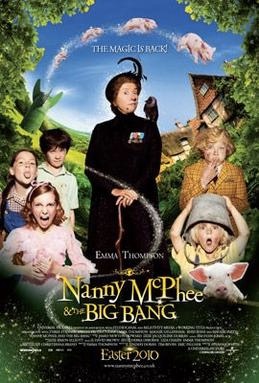
It is the editing and music which work collaboratively, creating a magical moment. The music is introduced through descending strings, which transitions into a light and playful melody heavily dominated by flutes and accompanied by lower wind instruments. The high pitch of the flutes creates an intriguing, yet mischievous atmosphere, all being attributes of Mr Edelweiss. This music is expressed through a single eighteen second take, accompanied by a tracking shot, which also creates an enchanting and hypnotic tone to the scene. The viewer is unable to take their eyes off Mr Edelweiss, which correlates with the frozen positioning of the children within the frame (Figure 1). As he is weaving through the children an ascending pace and pitch can be identified, building up the excitement and awe of this moment and successfully representing Mr Edelweiss as a heroic character once he returns the letters to Nanny McPhee (Figure 2). Despite the crow living up to his Jackdaw name the music is establishing it as a positive steal with kind and helpful intentions.
It appears, however, that Nanny McPhee does not view this as an act of heroism, but rather an ostentatious display of his ability to fly. Figure four shows Nanny McPhee’s character expression to correlate with the tone of her dialogue. Looking over her shoulder at the pleased Mr Edelweiss after he has retrieved the letters. It is the stern tone of Nanny McPhee that suggests her disapproval of the character through referring to him as a “naughty bird” and “tiresome creature” whilst he is weaving himself through the children (Figure 5). She appears impatient and unimpressed (Figure 4), and thus condemns his animality through using terms such as “naughty” and “creature”, producing hateful connotations, suggesting her overall perception of the character. Human’s who are displeased with an animal doing something they do not want them to be doing is a common convention of animals in film, however, this scene is unique as Mr Edelweiss is performing a supportive and empathetic deed. Due to Nanny McPhee’s antagonistic behaviour her disapproving nature can be viewed as unjustified and heartless, as Mr Edelweiss is trying to prevent her magic from causing catastrophic consequences. If Mr Edelweiss had not swooped in to retrieve the letters, we can question what would have happened once Nanny McPhee used her stick to unfreeze the setting. Mr Edelweiss’s actions are crucial in foreshadowing the hero he becomes at the end, with his putty eating habits enabling Megsie to cut through the wire of the unexploded bomb that lands in their field (Figure 6).
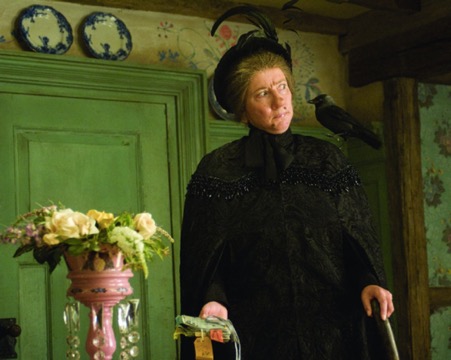
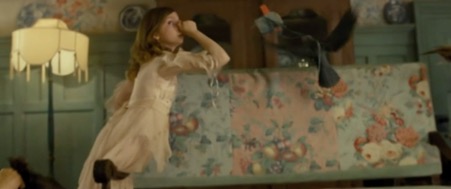
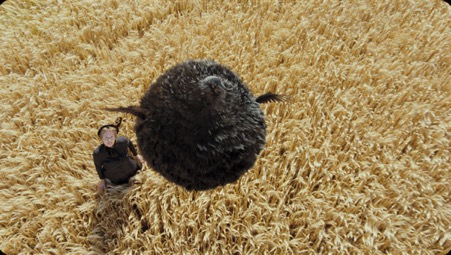
The extra diegetic soundtrack and the editing work together to produce a ‘loveable rogue’, likewise to the ‘Harlequin’ stock character from Commedia Dell’Arte, a character who is playfully mischievous but also serves those higher than them, both being attributes of the Jackdaw. (Figure 7). Through labelling the crow under the title of the ‘Harlequin’ character, it enables the young spectators to recognise the attributes of Mr Edelweiss with other playful characters they have encountered, as the ‘Harlequin’s’ characteristics is still a regularly followed format of character building. This enables room for predicting how the character will progress, they will know from this scene that Mr Edelweiss wants to please and win over Nanny McPhee which could lead to the hypotheses that he will be the hero at the end of the film.
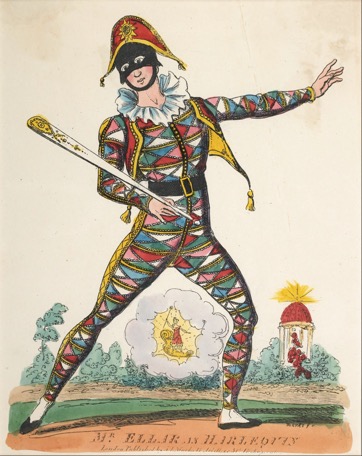
Nanny McPhee’s and Mr Edelweiss’s relationship is a progressive journey, with frequent moments of disapproval from the human side. Through an exploration of stock characters and combining these with the children’s film genre, it can be concluded that Mr Edelweiss is the saviour of this scene. Through the use of memorable and unique cinematography, playful instruments and harsh dialogue, it is clear that despite his efforts, Mr Edelweiss is unable to impress the one person he wishes to the most, meaning that at the next opportunity, he will have to try harder at winning over his companion.
Bibliography
Frings, Hubert and Mable, ‘The Language of Crows’ Scientific American, 201.5 (1959), 119-133 ,<https://www.jstor.org/stable/24941154> [Accessed 1 November 2021]
Katritzky, M. A. The Art of Commedia: A Study in the Commedia Dell’Arte 1560-1620 with Special Reference to the Visual Records, (Amsterdam: Rodopi, 2006)
White, Susanna, dir., Nanny McPhee and the Big Bang (Universal Pictures, 2010)